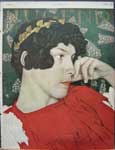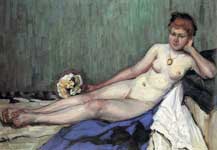Paintings

Bacchant

Nino Cesarini

Nude with bouquet

Pierrot
Paul Hoecker, (11. August 1854 Oberlangenau Habelschwerdt district in Silesi, - † 13. January 1910 Munich) was a German Painter of the Munich School and a founding member of the Munich Secession.
Paul Hoecker (1854-1910)
Childhood and Youth
"The Plan" in Upper Langenau in the county of Glatz in Silesia was his parents' house, "Hoecker-house," pointing to the numerous coats of arms and family portraits for a long, prosperous gender row. Here he was on 11 Born August 1854. "The fine arts, he received no further stimulus to the parental home, but he had inherited a rich musical talent from her mother. His inclination for art had gradually developed during the school day. In the time since he attended high school at Neustadt, in Silesia, he was at least due to his humorous drawings, caricatures of his teachers known ". [1]
The Hoecker-house. Paintings by Paul Hoecker (1900)
Training at the Academy
On 19 October 1874 [2] He was inducted into the Royal Academy of Fine Arts in Munich, which he attended until spring 1879th His education he received at the genre and landscape painter Wilhelm von Diez. "From his school came artists who are distant from the primary orientation of the novelistic genre. Many of his students later became members of the Munich Secession and prepared Impressionism and Art Nouveau ". [3]
Apprenticeship and journeyman years
In May 1882 he went to Paris and then to Holland, according to Holstein and the German seaports and then back to Munich. In Munich, Hoecker was a friend of Fritz von Uhde, Piglhein Bruno and Max Liebermann. In 1883, he has performed with genre paintings from the Netherlands and interiors at the Munich International Art Exhibition, in which was combined with delicacy of the characteristics of a great coloristic skill in the treatment of chiaroscuro. [4] In 1883 he traveled again to Paris and Holland. From January to autumn 1884 he has been active again in Munich, then moved to Berlin. In 1888 he went back to Munich and joined the modern naturalistic Malrichtung by putting the emphasis on the strong play of light effects.
The activities as a teacher at the Munich Academy
Paul Hoecker was the first December 1891 as a professor at the Royal Academy of Fine Arts in Munich called. "With 36 years he worked for that time very young for this appeal." He took over from Friedrich August von Kaulbach orphaned painting class at the academy. [4] He was the first teacher at the Academy, was in the summer to paint from Country ventured on to Haimhausen, Utting Ammersee, Breitbrunn am Chiemsee, etc. He does not put a model in which one had to be a week or two to work tired - painted was all that was luck to the young Hoecker students were most joyfully work [4]. "He went with his disciples into the country, where they housed often sorely oppressed and poor, full of zeal was known as" "were brought up, but even after Künstlerart the" true fanatic of the work otium cum dignitate enjoyed "and going about with a lot of stamina of their art ". [5] the first modern Hoecker was at the academy. But he did not teach modernity after paragraph, he suggested to look for and find yourself. "Paul Hoecker his students the art of the Barbizon School, the Impressionists and Neo-Impressionists and the new currents of Dachau and Worpswede mediated" [6] "... I was then (1895) in the class of Professor Hoecker, who with his students in summer semester, the plein-air painting operation. I was finally in place. Even the students were stimulating enough to ...... fruitful apprenticeship ". [7]" Paul Hoecker was receptive to the signals of "new Dachau" and "Worpswede" and that his students had passed on. Thus the nature lyricism the spiritual basis of the "soil" and drew on the work of the Working Group in the "Youth" field. It was about the individual experience of the essence and the universal implementation of pictorial means. The human eye unseen was brought from the depths of the cosmos into the picture, from the reflection of the mutual interpenetration of man and nature, the great connections are made. "" The call to come from the Hoecker-school, was in Munich of the nineties recommendation, which is always and everywhere opened the floodgates ". [8]" ... his chameleon-like and problematic nature proved ... to be appropriate to train a whole generation of excellent illustrators ". [9]" hump held at the beginning of the nineties at the Munich Academy is a highly visited the studio. This was a so-called "genius kit", what on best young talents at that time was in Munich rallied themselves to hump, an ideal teacher who trod no independent seed ever to the professorial authority's sake, but like no other on each individual appearance with his students to respond and they did cultivate for the good side. He struck his people do not all have the same bar and they do not "drilled". He much was with them for nature: a summer in Neubeuern at Baron January Wendelstadt, another in Utting am Ammersee, then another, in a narrow circle, in the Swabian Alb, in Munderkingen, brought the students among themselves, the students and teachers close to each other. The foundation of the "soil" was then obtained by himself in 1899, the young group met in the Glass Palace in Munich for the first time to the public and has since come back year after year with rich gifts ". [10]
Paul Hoecker and the Munich Secession
The strong influence of Franz Lenbach in Munich exhibitions of modern art movements had very little space. Hoecker was on 1 December 1891 appointed professor. A few months later, on 4 April 1892, it was worked jointly by him the founding of the Secession, whose board he was acting as Secretary. The Munich Secession was the first in Germany, wanted to enable new forms of painting and exhibiting. In other cities (including Berlin), later followed by similar divisions.
Farewell to the Academy
Hoecker 1897 comes with a picture of the Madonna in a scandal by which he prefers to give up his teaching at the Academy. He was rumored that he has taken a male prostitute as a model for what he used to have private contacts. [11]
Stays in Italy and Upper Langenau
"In Italy, Paul bumps came in contact with the poet Jacques d'Adelsward Heels, who had also withdrawn after a scandal in Paris to his villa in Capri lysis. Meanwhile, Nino Cesarini, Paul Hoecker lovers in the years to paint several times. Guglielmo Plüschow has repeatedly held inside the Villa Lysis, in a photograph on the left you can see the painting on the wall Nino with a green cloth, which came into existence only in the last years cusp. Already before 1904 he had painted with blue cloth Nino under trees. At this point, seems to be scandal in Munich to have been forgotten, or at least dared the magazine "Youth" is a different version of the painting (Nino dressed), as number 26 to print a title page. "" In 1901, he returned to his beloved home village of Upper Langenau where he lived from then on his work and his passions. With exquisite art treasures, he paid off his father's house. The "Hoecker house," his artists' residence, has become a tourist attraction. [11] In 1910, he died in a Munich hospital on "Roman malaria". The Langenauer Hoecker-house with the studio took over hump niece Vally Walter.
Assessment of his painting
"Hump representing the typical line of the Munich tradition gently steered into newer cars painting, but avoided the too daring. He met with his lyrical, sentimental, mostly religious themes (nuns in porches or in front of images of Christ in prayer and meditation), but also with the south German carnival scenes taste of the end of the century. In his painting he showed pleinairistischen with a lure paint an amazing "detail-Impressionism," ..... Filtered through leaves and branches sunspots he did masterfully portray. In it expressed its proximity to Max Liebermann and Fritz von Uhde, with whom he was friendly "[12]
Student of Paul Hoecker
Gustav Bechler
Max Barascudts
Emil Boehm
Ernest George Dodge
Paul Walter Ehrhardt
Reinhold Max Eichler
Felix Eisengräber
Max Feldbauer
Walter Georgi
Adolf Höfer
Fritz Hofmann
Angelo Jank
Carl August Liner
O. Lohse
Ferdinand Mirwald
Karl Hermann Müller-Samerberg
Adolf Munzer
Rudolf Nissl
Paul Bruno
Walter Püttner
Putz
Ferdinand von Reznicek
Fritz Rhine
Emil Schill
Karl Schmoll of Eisenwerth
Wilhelm Schulz
Henry Strieffler
Franz Wilhelm Voigt
Fritz Wimmer
Museums
Leipzig Museum of Fine Arts (Bruckmann)
Munich: Neue Pinakothek (Bruckmann)
Literature
Friedrich Boetticher: Painting works of the 19th Century. Dresden, 1891 - 1901.
Bruck's lexicon of Fine Arts. Munich painters in the 19th Century, Munich 1982nd
Meyers in 1910.
Birgit Jooss: "... the first modern age in the old Academy" - the teacher, Paul Höcker, in: The plaice. A group of artists from Secession and the Blue Rider. Edited by Siegfried Unterberger, Felix Billeter and Ute Strimmer. Munich 2007, pp. 28-43
Neue Pinakothek in Munich: The Munich School 1850 - 1914. Exhibition catalog, Munich 1979th
Andrew Stern Weiler (eds): Goodby to Berlin, 100 Years of the Gay Movement, Berlin 1997. ISBN 3-86149-051-x
Paul Hoecker. In: Ulrich Thieme, Felix Becker, among others: general lexicon of visual arts from antiquity to the present. Volume 17, EA Seemann, Leipzig 1924, p.184
Paul Hoecker and his school. Fritz v. Ostini. In: Velhagen & Klasing's Monatshefte, XXVII. Born in 1912/1913, 6th Issue February 1913, pp. 161 ff m. Figure
Web Links
Commons: Paul Hoecker - album of pictures and / or video and audio files
Notes and references
↑ Paul Price: Painter Professor Paul Hoecker. East German homeland 1973rd
↑ http://matrikel.adbk.de/05ordner/mb_1841-1884/jahr_1874/matrikel-03057/?searchterm=Paul% 20Hoecker enrollment
↑ Brigitte Langer: The Munich-based artist's studio of historicism. Dachau 1992nd ISBN 3-89251-135-7.
↑ abc Fritz von Ostini: Paul Hoecker and his school. Velhagen & Klasing's Monatshefte, Issue 6, February 1913.
↑ J. Schmidt: The hump Paul Glatz, Glatz first September 1918.
↑ Andrea Jedelsky: Putz and the soil. Catalogue of the Exhibition 1999 at the Galerie Schüller.
↑ Hartfrid Neunzert (ed.): Adolf Munzer. Paintings 1899 - 1919, Art History from Landsberg, Issue 14, Landsberg 1996th
↑ Bernd Dürr: Putz, Max Bauer field and the circle of "soil" and "youth" in Dachau in 1900. Dachau 1989th
↑ Ruth Stone: Putz. With a list of paintings and designs imagewise, Vienna 1974th
↑ Dr. Georg Jakob Wolf: The "soil", in: "Art and Artists in Munich", Strasbourg 1908, H. 12, at 82
↑ from Magnus Hirschfeld: From Einstein to now, Berlin 1986th ISBN 3-921495-61-X.
↑ Clementine Schack von Wittenau: Karl Schmoll of Eisenwerth, painting, graphic art, glass art, Stuttgart 1995th ISBN 3-925369-47-3, p.20
Art Books, Germany
Retrieved from "http://en.wikipedia.org/ ", Text is available under the Creative Commons Attribution-ShareAlike License
